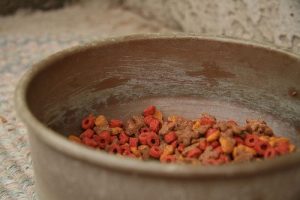We may know what to look for when reading labels for the food we eat – like fat grams per serving, calories, sugar and sodium content or other key ingredients. Usually a quick glance at the label is all it takes to know whether or not we want to eat it. The same is not true for our pet’s food. The bag or box may be bright colored and wholesome looking, filled with meat and vegetables; however brand labeling can be deceiving.
quick glance at the label is all it takes to know whether or not we want to eat it. The same is not true for our pet’s food. The bag or box may be bright colored and wholesome looking, filled with meat and vegetables; however brand labeling can be deceiving.
The list of ingredients may be overwhelming and may not always make much sense. The U.S. Food and Drug Administration (FDA) ensures that pet food ingredients on the label are listed in descending order from the most weight to the least amount of weight. You may be thinking, “what does that mean for my pet?” Take a look at the next 5 ingredients, which can help you decide if what you are feeding your pet is right for them.
What does “meat” on the label mean?
Just because you see the word “meat” on the label, it does not guarantee you are getting beef or any other recognizable meat. If you see the words “meat-meal” on the label as an ingredient, it can mean that any kind of mammal tissue is added to the mix. Look for specific ingredients of meat, like lamb, chicken or other sources of real meat. In fact, the word “poultry” can mean anything from chicken to another kind of bird.
The protein source is very important to identify, and if the label shows a high percentage of crude protein, it does not ensure it is high quality protein. Again, look for specific sources of meat and stay away from bone meal or ‘corn gluten meal’, as these are not readily absorbed by your pet’s digestive system the way that real-meal proteins are.
What Exactly Are Byproducts?
Would you want to eat any food that contained the word “byproducts” on the label? Probably not – when you see the words “chicken byproducts” for example, it can mean everything from ground chicken parts including beaks and feet. You want to stay away from any food that lists byproducts on the label.
What About Carbohydrates?
While us humans may be restricting our carbs, this rule does not necessarily apply to our pets. Just like anything else, there are good and bad carbohydrates. The same holds true for our pets. Whole grains are definitely the way to go (like ground rice) when it comes to feeding our pets, as this will provide more nutritional value. Stay away from wheat or corn flour, as these sources tend to be highly processed.
Our Pets Still Need Good Fats
Good fats are necessary for both animals and people. We need good fats for our hair to be shiny, and so does Fido, whose skin and fur depend on it. Fats are also necessary to transfer all the vitamins and minerals from the food into the cells and tissues. We also need good fats for the liver and kidneys to function properly, and the same holds true for our pets. Essential fatty acids play a key role in keeping our pet’s fur in tip-top condition. Chicken fat, flaxseed oil and sunflower oil are all good sources for this very important ingredient.
Take the time to read the label, and if you are not sure, ask your veterinarian or holistic healthcare practitioner for advice. This is especially true if your pet is dealing with a specific medical condition or digestive problem. Our pets deserve the best food we can afford to give them.
Photo: Courtesy of youngthousands via Flickr (CC by 2.0)









